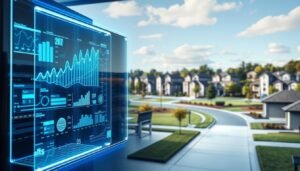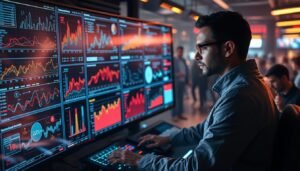Data analysis has become a cornerstone of decision-making in various fields. One of the most powerful tools for this purpose is a programming language designed specifically for statistical computing and visualization. This language, known for its versatility, has gained immense popularity among data scientists and analysts.
Originally developed in the 1990s, this language has evolved into a robust platform for handling complex datum sets. Its ability to create detailed graphs and run intricate calculations makes it a favorite among professionals. Whether you’re plotting trends or analyzing large datasets, this tool offers unparalleled flexibility.
This article will walk you through the basics, from setting up the environment to exploring advanced features. Whether you’re a beginner or looking to refine your skills, you’ll find valuable insights here. Let’s dive into the world of data analysis and discover how this language can transform your workflow.
Key Takeaways
- Learn the basics of a powerful statistical computing tool.
- Understand its historical background and current relevance.
- Explore its advanced data visualization capabilities.
- Get started with installation and essential packages.
- Gain practical insights for real-world applications.
Getting Started with R Programming
Statistical computing has revolutionized how we interpret and visualize data. This powerful approach enables professionals to analyze complex datasets and generate actionable insights. Among the tools available, one stands out for its versatility and ease of use.
What is This Tool?
Originally developed as an implementation of the S language, this tool has evolved into a robust platform for data analysis. It supports various data types and offers extensive libraries for statistical computing. Whether you’re working with small datasets or massive data streams, it provides the flexibility needed to handle diverse analytical tasks.
Why Choose It for Data Analysis?
There are several reasons why this tool is favored by data professionals:
- Graphical Capabilities: It excels in creating high-quality graphs, making it easier to visualize trends and patterns.
- Flexibility: Its open-source nature allows users to customize functions and integrate with other platforms.
- Ease of Learning: Beginners can quickly grasp its syntax, while experts can leverage advanced features for complex analyses.
“The ability to generate quick statistical reports and detailed visualizations makes it a go-to choice for data analysts.”
Here’s a quick comparison of its features with other popular tools:
| Feature | This Tool | Alternative A | Alternative B |
|---|---|---|---|
| Graph Quality | High | Medium | Low |
| Flexibility | Extensive | Limited | Moderate |
| Ease of Learning | Beginner-Friendly | Advanced | Intermediate |
Its integration with other programming environments further enhances its appeal. Whether you’re a novice or an expert, this tool offers the features needed to streamline your data analysis workflow.
Installing R and RStudio
Setting up the right tools is the first step toward mastering data analysis. Whether you’re a beginner or an experienced user, installing the necessary software ensures a smooth start to your analytical journey. This section will guide you through the process of installing R and RStudio, detailing system requirements and the advantages of using an integrated development environment.
System Requirements and Setup
Before diving into installation, it’s essential to ensure your system meets the minimum requirements. R runs efficiently on most modern operating systems, including Windows, macOS, and Linux. Here’s a quick overview of the steps for each platform:
- Windows: Download the installer from the CRAN website and follow the on-screen instructions.
- macOS: Use the provided .pkg file for a straightforward installation process.
- Linux: Install via your distribution’s package manager or compile from source.
Once R is installed, the next step is to set up RStudio. This integrated development environment (IDE) enhances your workflow with features like syntax highlighting, debugging tools, and a user-friendly interface. It’s a must-have for anyone serious about data analysis.
Why Use RStudio?
RStudio offers several advantages that make it the preferred choice for many users:
- Ease of Use: Its intuitive interface simplifies coding and debugging.
- Enhanced Productivity: Features like code completion and project management save time.
- Seamless Integration: It works seamlessly with R, making it easier to manage scripts and data.
“RStudio transforms the way you interact with R, making complex tasks more manageable and efficient.”
Installing Essential Packages
One of the strengths of R is its extensive library of packages. These packages extend the core functionality, enabling advanced tasks like datum visualization and statistical modeling. Here’s a quick guide to installing and managing packages:
- Open R or RStudio and use the
install.packages()function. - Specify the package name, e.g.,
install.packages("ggplot2"). - Load the package using
library()to start using its functions.
For beginners, resources like W3Schools provide straightforward instructions to help you get started quickly. The installation process is well-documented, ensuring accessibility even for those without prior experience in programming.
| Feature | R | RStudio |
|---|---|---|
| Interface | Basic | Advanced |
| Debugging Tools | Limited | Comprehensive |
| Package Management | Manual | Streamlined |
With R and RStudio installed, you’re ready to explore the world of data analysis. The next section will introduce you to the R environment and its core features.
Understanding the R Programming Environment
The R environment offers a dynamic workspace for tackling data challenges. Its interactive nature makes it a go-to tool for professionals in diverse fields. Whether you’re handling small datasets or large-scale projects, this environment provides the flexibility needed for efficient workflows.
At its core, the R environment includes three main components: the console, script editor, and workspace. The console allows for immediate execution of commands, while the script editor helps organize and save your code. The workspace stores all active variables and data, making it easy to manage your analysis tasks.

One of the standout features of R is its ability to simplify complex analysis and visualization tasks. With built-in functions and user-contributed packages, you can create detailed graphs and charts with minimal effort. This makes it an ideal choice for professionals who need to present data insights clearly and effectively.
The environment also excels in supporting machine learning and statistical modeling. From regression analysis to clustering algorithms, R provides a wide range of tools for advanced tasks. Its extensive library of packages ensures that you have access to the latest techniques and methodologies.
RStudio enhances the R environment with a user-friendly interface and powerful features. Its layout includes a script editor, console, and workspace viewer, all within a single window. This streamlined design helps users navigate and manage their work more efficiently.
“RStudio transforms the way you interact with R, making complex tasks more manageable and efficient.”
Here’s a quick overview of the benefits of the R environment:
- Reproducible Research: Easily document and share your work for consistent results.
- Streamlined Workflow: Tools like RStudio simplify coding and debugging.
- Versatility: Handle diverse tasks, from basic analysis to advanced machine learning.
By mastering the R environment, you can unlock its full potential and elevate your data visualization and analysis capabilities. Whether you’re a beginner or an expert, this environment offers the tools you need to succeed.
Writing Your First R Script
Starting your journey in data analysis begins with writing your first script. This step is crucial for building a strong foundation in datum analysis. By mastering basic commands, you’ll gain confidence and prepare for more complex tasks.
Outputting Text and Performing Calculations
Begin with simple commands like printing text. For example, type print("Hello World!") in the console to see your first output. This is a great way to get familiar with the syntax.
Next, try basic arithmetic. Enter 5 + 3 or 10 / 2 to perform calculations. These exercises help you understand how the console processes commands.
Using the R Console Effectively
The R Console is your workspace for executing commands. Here’s how to use it effectively:
- Execute Commands: Type directly into the console and press Enter to run the code.
- Modify Code: Use the up and down arrows to revisit previous commands and make changes.
- Save Scripts: Write your code in the script editor and save it for future use.
Common pitfalls include syntax errors and misplaced brackets. If you encounter issues, double-check your code or refer to online resources for support.
“The best way to learn is by doing. Start small, experiment, and build your skills step by step.”
For beginners, interactive “Try it Yourself” editors are a great way to practice. These tools allow you to test code in real-time and see immediate results.
Remember, the community is a valuable resource. Forums and online tutorials offer guidance and solutions to common problems. Engaging with others can accelerate your learning process.
By writing your first script, you’re laying the groundwork for more advanced datum analysis. Keep practicing, and soon you’ll be tackling complex tasks with ease.
Data Manipulation with R: Working with Data Frames
Handling data efficiently is a critical skill in modern data science. One of the most powerful tools for this purpose is the data frame, a structured format that organizes information into rows and columns. Mastering data frames is essential for cleaning, analyzing, and visualizing data effectively.
Importing and Cleaning Data
Before analyzing data, you need to import it into your workspace. Data can come from various sources, such as CSV files, databases, or APIs. For example, the read.csv() function is commonly used to load CSV files into a data frame.
Once imported, cleaning the data is the next step. This involves handling missing values, removing duplicates, and correcting inconsistencies. Built-in functions like na.omit() and unique() simplify these tasks. Proper cleaning ensures accurate results in your analysis.
Basic Data Frame Operations
Data frames support a wide range of operations to help you explore and manipulate data. Here are some essential tasks:
- Filtering: Use the
subset()function to extract specific rows based on conditions. - Sorting: Arrange data with the
order()function for better insights. - Summarizing: Calculate statistics like mean or median using the
summary()function.
These operations are fundamental for preparing data for advanced analysis. They also help identify patterns and trends in your dataset.
“Cleaning and organizing data is the foundation of any successful analysis. Without it, even the most advanced techniques can lead to misleading results.”
Here’s a comparison of common data frame functions:
| Function | Purpose | Example |
|---|---|---|
read.csv() | Import CSV files | read.csv("data.csv") |
na.omit() | Remove missing values | na.omit(df) |
subset() | Filter rows | subset(df, column > 10) |
Despite its robust features, working with data frames can sometimes lead to report errors. Common issues include mismatched data types or incorrect column names. To resolve these, double-check your data and use functions like str() to inspect the structure of your data frame.
By mastering data frames, you’ll unlock the full potential of your data science projects. Whether you’re cleaning messy datasets or performing complex analyses, these skills are indispensable for success.
Visualizing Data in R
Visualizing data effectively is key to uncovering meaningful insights. Graphs and charts transform raw numbers into clear, actionable information. This makes it easier to identify trends, patterns, and outliers in your data.
One of the most powerful tools for this purpose is ggplot2, a robust library in the programming language used for data analysis. It allows you to create a wide range of graphs, from scatter plots to bar charts, with just a few lines of code.

Creating Graphs with ggplot2
ggplot2 simplifies the process of building complex visuals. Start by loading the library with library(ggplot2). Then, use the ggplot() function to define your data and aesthetics. For example, a scatter plot can be created with:
ggplot(data, aes(x=variable1, y=variable2)) + geom_point()This flexibility makes it a favorite among data professionals. Whether you’re working with small datasets or large-scale projects, ggplot2 ensures your visuals are both accurate and impactful.
Customizing Plots for Better Insights
Customization is where ggplot2 truly shines. You can adjust colors, themes, and labels to make your graphs more informative. For instance, adding a title and axis labels can improve viewer comprehension:
ggplot(data, aes(x=variable1, y=variable2)) + geom_point() + labs(title="Scatter Plot", x="X-Axis", y="Y-Axis")Experimenting with different themes and color schemes can also enhance the visual appeal. This is especially useful when preparing charts for presentations or publications.
“A well-customized graph not only looks professional but also communicates insights more effectively.”
Here are some practical tips for integrating statistical techniques into your visuals:
- Use trend lines to highlight patterns in scatter plots.
- Add error bars to show variability in your data.
- Incorporate clustering algorithms to group similar data points.
By mastering these techniques, you can create polished, publication-ready charts that support data-driven decision-making. Whether you’re analyzing trends or presenting findings, ggplot2 offers the tools you need to succeed.
Leveraging R Packages and Libraries
The power of data analysis lies in its ability to transform raw information into actionable insights. One of the key factors that make this possible is the extensive ecosystem of packages and libraries available for R. These resources extend the functionality of the base language, enabling users to tackle a wide range of analytical tasks with ease.
Exploring CRAN Resources
CRAN (Comprehensive R Archive Network) is the central repository for R packages. It hosts thousands of libraries tailored to specific analytical needs. Whether you’re working on data visualization, machine learning, or statistical modeling, CRAN likely has a package to help.
To explore CRAN, visit the official website and use the search function to find packages. Popular examples include ggplot2 for visualization and dplyr for data manipulation. These libraries are widely used and well-documented, making them ideal for both beginners and experts.
Installing and Updating Packages
Installing packages in R is straightforward. Use the install.packages() function followed by the package name. For example, to install ggplot2, type install.packages("ggplot2"). Once installed, load the package with library() to start using its functions.
Keeping your packages up-to-date is equally important. Use the update.packages() function to ensure you have the latest versions. This helps avoid compatibility issues and ensures you can use the most recent features.
Despite its simplicity, package installation can sometimes lead to errors. Common issues include missing dependencies or network problems. If you encounter an error, double-check your internet connection or consult the package documentation. The community support forums are also a valuable resource for troubleshooting.
“The R community is incredibly active, constantly developing new libraries to meet evolving data science needs.”
By leveraging the vast array of packages and libraries available, you can significantly enhance your data analysis capabilities. Whether you’re a novice or an expert, these resources provide the tools you need to succeed in your projects.
Advanced Statistical Computing and Machine Learning
Machine learning and statistical modeling are reshaping how we approach complex data challenges. These advanced techniques allow professionals to uncover hidden patterns, make accurate predictions, and drive informed decisions. With the right tools, you can transform raw data into actionable insights.
Building Statistical Models
Building statistical models is a cornerstone of advanced analytics. These models help you understand relationships within your data and predict future outcomes. Whether you’re working on regression or classification tasks, the process involves selecting the right variables, training the model, and validating its accuracy.
One of the strengths of the language used for this purpose is its extensive package ecosystem. Libraries like caret and randomForest simplify model building and evaluation. These tools ensure that your models are both robust and reproducible.
“A well-validated model not only provides accurate predictions but also offers insights into the underlying data structure.”
Visualizing Model Performance
Visualization plays a critical role in model diagnostics. By creating plots, you can analyze residuals, assess model fit, and identify potential issues. Tools like ggplot2 make it easy to generate professional-quality visuals that enhance your understanding of the model’s performance.
For example, a residual plot can reveal whether your model assumptions hold true. Similarly, a ROC curve provides a clear window into the trade-offs between sensitivity and specificity in classification tasks.
Bridging Theory and Practice
The language used in advanced analytics bridges the gap between theoretical statistical techniques and practical datum science applications. This makes it easier to apply complex algorithms to real-world problems. Whether you’re analyzing customer behavior or predicting market trends, these tools offer the flexibility needed for success.
Here’s a quick overview of key steps in the modeling process:
- Data Preparation: Clean and preprocess your data for analysis.
- Model Selection: Choose the right algorithm for your task.
- Training and Validation: Split your data and evaluate model performance.
- Visualization: Use plots to interpret results and communicate findings.
By mastering these techniques, you can unlock the full potential of advanced statistical computing and machine learning. Whether you’re a beginner or an expert, these skills are essential for tackling today’s data challenges.
Integrating R Programming with Other Tools
Combining different tools can unlock new possibilities in data analysis. By integrating R with other languages like C, C++, and Python, you can enhance its utility and broaden its application scope. This technique allows you to leverage the strengths of multiple programming solutions simultaneously, creating a more versatile workflow.
Interoperability with C and C++
Linking R with C or C++ is a powerful technique for performance optimization. These languages are known for their speed and efficiency, making them ideal for computationally intensive tasks. For example, you can write critical sections of your code in C++ and call them directly from R using packages like Rcpp.
This approach not only improves execution speed but also allows you to reuse existing C/C++ libraries. Whether you’re working on complex simulations or large-scale data processing, this integration can significantly boost performance.
Connecting R with Python
Python is another popular language that complements R’s capabilities. By integrating the two, you can combine R’s statistical prowess with Python’s extensive libraries for machine learning and data processing. Tools like reticulate make it easy to run Python code within R scripts.
For instance, you can use Python’s <em>pandas library for data wrangling and then switch to R for advanced statistical analysis. This seamless interoperability ensures you can choose the best tool for each task without compromising efficiency.
“Integrating R with other languages is a game-changer for data professionals, enabling them to tackle diverse challenges with a unified toolkit.”
Practical Examples and Best Practices
Here are some practical examples of how you can integrate R with other tools:
- Data Processing: Use Python for preprocessing and R for visualization.
- Performance Optimization: Write critical functions in C++ and call them from R.
- Workflow Automation: Combine R scripts with Python scripts for end-to-end automation.
To achieve seamless integration, it’s essential to follow best practices. Start by identifying the strengths of each language and use them accordingly. Additionally, leverage resources like documentation and community forums to troubleshoot any issues.
For those looking to deepen their skills, the data science journey guide provides valuable insights into mastering these integrations. By combining the strengths of R, Python, and C/C++, you can create a robust and flexible analytical toolkit.
Best Practices for Debugging and Error Resolution in R
Effective debugging is essential for maintaining a smooth workflow in data analysis. Identifying and resolving errors quickly can save hours of frustration and ensure your projects stay on track. This section outlines common pitfalls and provides actionable tips to help you troubleshoot efficiently.
Common Pitfalls and How to Avoid Them
One of the most frequent challenges is syntax errors. These often occur due to misplaced brackets or typos. Double-check your code and use tools like RStudio’s syntax highlighting to catch mistakes early.
Memory management is another common issue. Large datasets can overwhelm your system, leading to crashes. To avoid this, optimize your code and use functions like gc() to free up memory.
Package compatibility can also cause problems. Ensure all dependencies are installed and up-to-date. If you encounter an error, consult the package documentation or community forums for solutions.
Actionable Debugging Techniques
Reading error messages carefully is the first step in resolving issues. These messages often provide clues about what went wrong. Use RStudio’s built-in debugging tools to step through your code and identify the source of the problem.
Systematic testing is another effective approach. Run your code on different platforms, such as linux, to uncover OS-specific issues. This helps ensure your scripts work seamlessly across environments.
“Proactive debugging not only saves time but also improves the quality of your code.”
Leveraging Community Resources
Community forums and resources like w3school are invaluable for troubleshooting. These platforms allow you to learn from others’ experiences and find solutions to common problems. Engaging with the community can also help you stay updated on best practices.
For beginners, interactive tutorials on w3school provide a hands-on way to learn debugging techniques. These resources are especially helpful for understanding complex error messages.
Proactive Practices for Error Resolution
Adopting proactive practices can prevent errors before they occur. Regularly test your code and use version control to track changes. This makes it easier to identify and fix issues quickly.
Finally, document your debugging process. Keeping a record of resolved errors helps you avoid repeating the same mistakes and improves your overall efficiency.
Conclusion
Mastering data analysis tools opens doors to impactful decision-making. From setting up your environment to integrating with other platforms, this journey has covered essential steps to enhance your skills. A solid introduction lays the groundwork for exploring advanced techniques like visualization and machine learning.
Now is the time to test your knowledge. Apply the techniques you’ve learned and experiment with new functions. Each step builds confidence and deepens your understanding of these powerful tools.
Remember, every expert was once a beginner. Your introduction to this field is just the start. Keep exploring, practicing, and applying your skills to real-world challenges. The more you test and refine your approach, the more proficient you’ll become.
Continue your learning journey with curiosity and determination. The tools and techniques you’ve discovered here are your foundation for success. Embrace the possibilities and let your skills drive meaningful change.
FAQ
What is R Programming?
R is a powerful language used for statistical computing and data analysis. It’s widely adopted in data science for its flexibility and extensive library support.
Why Choose R for Data Analysis?
R is ideal for data analysis due to its robust statistical techniques, data visualization capabilities, and active community support. It’s perfect for handling complex datasets and creating insightful reports.
What Are the System Requirements for Installing R and RStudio?
R and RStudio are compatible with Windows, macOS, and Linux. Ensure your system meets the minimum RAM and processor requirements for smooth performance.
How Do I Write My First Script in R?
Start by opening the R console or RStudio. Use basic commands to output text or perform calculations. Save your script with a .R extension for future use.
How Can I Import and Clean Data in R?
Use functions like `read.csv()` to import data. Clean your dataset by handling missing values, removing duplicates, and transforming variables as needed.
What Are the Best Tools for Data Visualization in R?
The `ggplot2` package is a popular choice for creating graphs. It offers customizable plots to help you visualize trends and patterns effectively.
How Do I Install and Update Packages in R?
Use the `install.packages()` function to add new libraries. For updates, run `update.packages()` to ensure you have the latest features and bug fixes.
Can R Be Integrated with Other Programming Languages?
Yes, R can interoperate with languages like Python, C, and C++. This makes it versatile for advanced statistical computing and machine learning tasks.
What Are Some Common Debugging Practices in R?
Use functions like `traceback()` to identify errors. Always test your code incrementally and refer to community forums for troubleshooting tips.
Where Can I Learn More About R Programming?
Resources like W3Schools, CRAN documentation, and online courses are great for beginners. The R community also provides extensive support for learners.





















